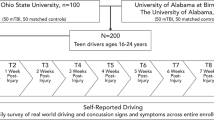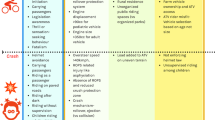Abstract
Traumatic brain injury (TBI) poses significant challenges for assessing fitness-to-drive (FTD) and determining the appropriate timing for return-to-driving (RTD) in civilian adults. This systematic review and meta-analysis protocol is designed to offer a comprehensive assessment of RTD timelines post-TBI, examining the effects of injury severity as well as demographic and clinical factors that influence driving capabilities. In response to gaps identified in previous literature—namely, the absence of recent systematic search strategies and thorough quality assessments—this study employs rigorous methodologies for literature search, data extraction, and evaluation of study quality. Our approach aims to provide reliable estimates and detailed analyses of subgroups within the TBI population. The findings aim to support clinical decision-making, inform RTD readiness, and potentially impact policy and driving assessment protocols. Ultimately, this review seeks to contribute to public safety measures, reduce traffic-related harm, and improve life outcomes for individuals recovering from TBI, thereby filling a vital research niche in neurotrauma rehabilitation.
Similar content being viewed by others
Data availability
All data used to perform this study are available within the paper and its Supplementary Information.
References
American Occupational Therapy Association (AOTA) (2020) Occupational therapy practice framework: domain and process. Am J Occup Ther 74:7412410010p1–7412410010p87. https://doi.org/10.5014/ajot.2020.74S2001
Rivara FP, Ebel BE, Binjolkar M, Wang J, Hanron A, Kroshus E, Boyle LN, Patrick KE (2022) Cognitive impairment and driving skills in youth after concussion. J Neurotrauma. https://doi.org/10.1089/neu.2022.0308
Rauchman SH, Zubair A, Jacob B, Rauchman D, Pinkhasov A, Placantonakis DG, Reiss AB (2023) Traumatic brain injury: mechanisms, manifestations, and visual sequelae. Front Neurosci 17:1090672. https://doi.org/10.3389/fnins.2023.1090672
Dams-O’Connor K, Juengst SB, Bogner J, Chiaravalloti ND, Corrigan JD, Giacino JT, Harrison-Felix CL, Hoffman JM, Ketchum JM, Lequerica AH, Marwitz JH, Miller AC, Nakase-Richardson R, Rabinowitz AR, Sander AM, Zafonte R, Hammond FM (2023) Traumatic brain injury as a chronic disease: insights from the United States Traumatic Brain Injury Model Systems Research Program. Lancet Neurol. https://doi.org/10.1016/S1474-4422(23)00065-0
Palubiski L, Crizzle A (2016) Evidence based review of fitness-to-drive and return-to-driving following traumatic brain injury. Geriatrics 1:17. https://doi.org/10.3390/geriatrics1030017
Downs SH, Black N (1998) The feasibility of creating a checklist for the assessment of the methodological quality both of randomised and non-randomised studies of health care interventions. J Epidemiol Community Health 52:377–384. https://doi.org/10.1136/jech.52.6.377
McGowan J, Sampson M, Salzwedel DM, Cogo E, Foerster V, Lefebvre C (2016) PRESS peer review of electronic search strategies: 2015 guideline statement. J Clin Epidemiol 75:40–46. https://doi.org/10.1016/j.jclinepi.2016.01.021
Dawson J, Johnston S, Marshall S, Schweizer TA, Reed N, Devos H, Schmidt J, Lithopoulos A, Zemek R (2023) Return to driving following concussion: a research priority. J Head Trauma Rehabil 38:277–278. https://doi.org/10.1097/HTR.0000000000000849
Alhashmi D, Lalor A, Fossey E (2022) Methods to evaluate driving competence for people with acquired brain injury (ABI): a systematic review. Front Rehabilit Sci 3:1020420. https://doi.org/10.3389/fresc.2022.1020420
Moher D, Shamseer L, Clarke M, Ghersi D, Liberati A, Petticrew M, Shekelle P, Stewart LA, PRISMA-P Group (2015) Preferred reporting items for systematic review and meta-analysis protocols (PRISMA-P) 2015 statement. Syst Rev 4:1. https://doi.org/10.1186/2046-4053-4-1
Egeto P, Badovinac SD, Hutchison MG, Ornstein TJ, Schweizer TA (2019) A systematic review and meta-analysis on the association between driving ability and neuropsychological test performances after moderate to severe traumatic brain injury. J Int Neuropsychol Soc 25:868–877. https://doi.org/10.1017/S1355617719000456
Guyatt GH, Oxman AD, Vist GE, Kunz R, Falck-Ytter Y, Alonso-Coello P, Schünemann HJ, GRADE Working Group (2008) GRADE: an emerging consensus on rating quality of evidence and strength of recommendations. BMJ 336:924–926. https://doi.org/10.1136/bmj.39489.470347.AD
Page MJ, McKenzie JE, Bossuyt PM, Boutron I, Hoffmann TC, Mulrow CD, Shamseer L, Tetzlaff JM, Akl EA, Brennan SE, Chou R, Glanville J, Grimshaw JM, Hróbjartsson A, Lalu MM, Li T, Loder EW, Mayo-Wilson E, McDonald S et al (2021) The PRISMA 2020 statement: an updated guideline for reporting systematic reviews. Rev Esp Cardiol (Engl Ed) 74:790–799. https://doi.org/10.1016/j.rec.2021.07.010
Author information
Authors and Affiliations
Contributions
AMF and TA conceived the study. AM developed the search strategy. AMF, FV, AM, and TA performed the preliminary search. BAM and RA reviewed the search strategy. RA and BAM will oversee data extraction and analysis. AMF and JGC produced the first draft of the manuscript. The definitive protocol was reviewed and approved by all authors (AMF, TA, FV, AM, BAM, RA and JGC).
Corresponding author
Ethics declarations
Ethics approval
This article does not contain any studies with human participants or animals performed by any of the authors.
Consent to participate
Not applicable.
Competing interests
The authors have no competing interests to declare that are relevant to the content of this article.
Additional information
Publisher’s Note
Springer Nature remains neutral with regard to jurisdictional claims in published maps and institutional affiliations.
Supplementary information
ESM 1
For more information on Appendix sections 1 and 2, see online supplementary material. Appendix A PRISMA-P checklist. Appendix B Medline search strategy. Supplementary material. (DOCX 18 kb)
Rights and permissions
Springer Nature or its licensor (e.g. a society or other partner) holds exclusive rights to this article under a publishing agreement with the author(s) or other rightsholder(s); author self-archiving of the accepted manuscript version of this article is solely governed by the terms of such publishing agreement and applicable law.
About this article
Cite this article
Müller Fiedler, A., Almeida, T., Vasconcellos, F.D.N. et al. Fitness-to-drive after adult civilian traumatic brain injury: protocol for a systematic review and meta-analysis. Neurosurg Rev 46, 324 (2023). https://doi.org/10.1007/s10143-023-02228-5
Received:
Revised:
Accepted:
Published:
DOI: https://doi.org/10.1007/s10143-023-02228-5




